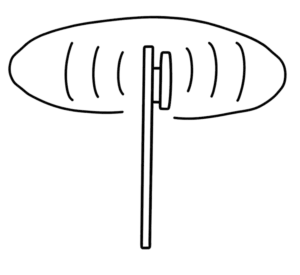Eventnet Support
omnidirectional antenna

What is an omnidirectional antenna?
An omnidirectional antenna is an antenna that distributes signals evenly in all directions. It is also known as an omni antenna. This means that it emits radio signals in a 360° angle around itself - similar to a lantern that emits light in all directions.
How does an omnidirectional antenna work?
An omnidirectional antenna transmits the signal in a circular pattern. Imagine you are standing in the middle of a room with a lantern in your hand. The light spreads evenly in all directions and illuminates the entire room. The omnidirectional antenna works in exactly the same way: it supplies all devices within its radius, regardless of their direction.
Energy distribution
With omnidirectional antennas, the available energy is distributed evenly in all directions. If, for example, as in Germany, an antenna is only allowed to transmit 100 MW (milliwatts), this power is distributed over 360°. This means that only a small part of the energy goes in each direction. As a result, the signal is equally strong in all directions, but the range is limited in each direction.
In comparison, a sector antenna concentrates the energy on a smaller area, which leads to a stronger signal there, but offers no coverage in other directions.
Advantages
Large area coverage
An omnidirectional antenna covers a large area around the antenna, making it ideal for locations where users are spread out in different directions.
Easy to install
As no alignment is required, omnidirectional antennas can be easily installed to ensure even coverage.
Flexible application
Whether in the home network, in offices or in public areas such as cafés - omnidirectional antennas are versatile as they can supply many devices simultaneously.
Disadvantages
Very limited range
The main disadvantage is that the energy is split between all directions. This means that the signal is not particularly strong in any direction and the range can be limited. In heavily used or extensive areas where a strong signal in a particular direction is required, sector antennas are often the better choice.
Areas of application
Omnidirectional antennas are often used in WiFi or hotspots as they offer the advantage of covering all devices in the vicinity. They are ideal for places where users are located in different directions around the antenna, for example in a café, an apartment or a small outdoor area.
Conclusion
The omnidirectional antenna is like a lantern that transmits signals evenly in all directions. It offers comprehensive coverage and is particularly suitable for locations where devices are distributed around the antenna. However, it has a limited range as the available energy is distributed in all directions.